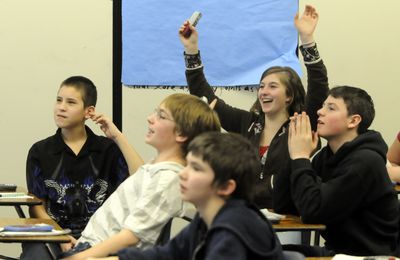Middle school includes all students
Cheney program keeps special ed in class, to continue at high school

Students who need specialized help in reading and math often feel stigmatized having to leave in the middle of class for special education.
“It made me feel kind of stupid,” one Cheney Middle School student said in a video the school produced.
Three years ago, school officials started teaching special education at the middle school in a new way. Instead of sending special-education students to a different room, two teachers now teach certain classes – one teacher for general education and one for special education.
The two teachers work together on curriculum and jump in if any student needs help – not just the special-education students. For the last period of each day, the special-education teacher meets with students to discuss what they learned and what they will be studying the next day.
“I like to brag about this model,” said co-principal Mike Stark.
The program was the brainchild of a committee formed by the school district to find ways to help special-education students.
“We were unsatisfied with how special-education students were performing,” Stark said.
After a year of research the committee decided on the new way of teaching and started the program with the sixth-graders who were entering the middle school.
Stark said the gap between the general-education students and the special-education students has narrowed, thanks to the program.
Erika Burden, Stark’s co-principal, said it is impossible to tell which students are in special education – even to some of the kids. One sixth-grader approached her earlier this year and asked her why he wasn’t in special education anymore, she said.
Stark and Burden said some special-education students probably wouldn’t benefit from this teaching model, and they’re still in a traditional program.
Soon, this year’s group of eighth-grade special-education students will move up to the high school. To accommodate them, Cheney High School will adopt this method of teaching special education in the fall.
To introduce the program to the high school, the middle school made a video of students talking about their experiences in traditional special-education classes, versus the way they learn now.
One student said she had to keep a card on her desk to remind her what time she had to go to the special-education room. She felt like the other students were staring at her when it was time for her to leave. Another said that other students would ask her where she went when she left the class and she’d lie about where she was going.
Several students said they didn’t feel challenged in the special-education classes. Sometimes, their regular classes were doing something interesting and they were starting to get into it when it was time to leave for their special-education classes.
Because of the success of the middle-school program, “we want to continue that model,” said Ray Picicci, assistant principal at the high school.
The high school has teamed language arts teacher Ryan Fitzgerald with special-education teacher Wes Hobbs. Math teacher Adam Marsh will teach with special-education teacher Bob Hilzendeger.
Marsh said he has team-taught classes before and is looking forward to the opportunity to do it again at Cheney High School. Fitzgerald said he’s looking forward to the program as well since it will be beneficial to the students and give him the chance to grow as a teacher.
As of now, the high school is expecting 10 students in math and six students in language arts to be involved in the program.
The principals and teachers agree the program wouldn’t work if the teachers weren’t willing to work together.
Both schools are excited to continue the teaching model at the high school and Stark said the students in the program now made the decision easy.
“These kids would have accepted nothing less,” Stark said.